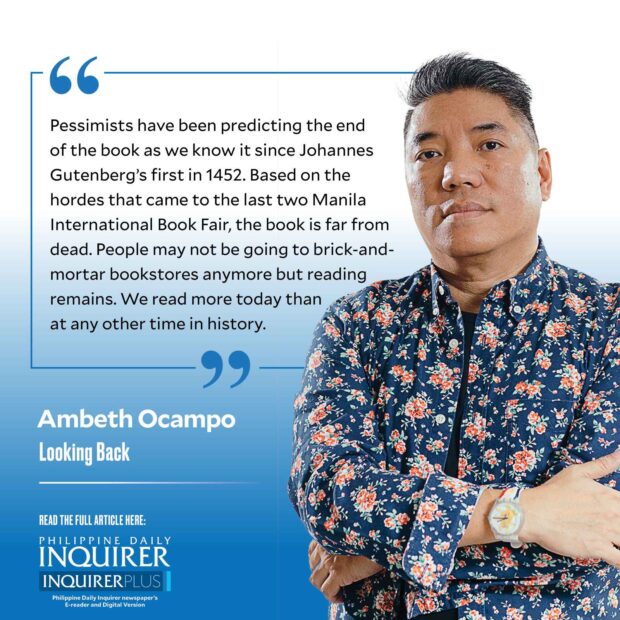
Many years ago, in an insane moment, I asked F. Sionil Jose and his wife Tessie if they would consider selling Solidaridad bookstore to me when they retired or grew tired of it. Years of browsing in small used bookstores abroad must have given me romantic views of a bookseller’s life. Fortunately, I did due diligence and the math. My dream evaporated when I realized that owning and running a bookstore are two separate things. Yet, I asked the Joses a second time if they would sell Solidaridad bookstore to me, and on one condition—they would lease the building to me for as long as it was used as a bookshop. Fortunately, the Jose children decided to step into their parents’ shoes, and so the iconic Solidaridad on Padre Faura Street remains family-owned now a few months short of its 60th birthday.
A small independent bookstore will never survive in a mall. Rent and associated costs alone would make the bookseller a slave to the landlord rather than the shop itself. During the pandemic, I considered an online bookstore until I recognized the hassle of packing and sending books by courier. I even considered taking a stall in the Legazpi Sunday Market or even a bourse table at the quarterly Bayanihan Collectors Club auction at the Ortigas Library, but gave up just thinking of the logistics of carting the books there, setting up, minding the stall, and packing up afterward. A bookstore for me is a way to engage face to face with other readers. You don’t get that online. I have not given up yet, inspired by the existence of Mt. Cloud in Baguio and Savage Mind in Naga.
Pessimists have been predicting the end of the book as we know it since Johannes Gutenberg’s first in 1452. Based on the hordes that came to the last two Manila International Book Fair, the book is far from dead. People may not be going to brick-and-mortar bookstores anymore but reading remains. We read more today than at any other time in history. We may not read physical newspapers and books as much as before, but everyone does read on smartphones, tablets, laptops, and desktops. We may not be reading classics like “The Tale of Genji” or “Don Quixote” that are bulky enough to reuse as door stoppers, but reading is reading, whether it be serious as “Florante at Laura,” “Noli me tangere,” and “Mga Ibong Mandaragit,” or simply the care label on your t-shirt. I may not own a bookstore yet, but I believe enough in reading and readers to keep writing this column and publishing books.
Looking back, my earliest memories of bookstores were of Popular Bookstore on Doroteo Jose which was the carrot my father dangled to get me into a dentist’s chair. Popular Bookstore didn’t have children’s books, but I liked just being in it as my father browsed the latest engineering texts for his classes in Mapua and University of the Philippines Diliman. The bookstore where I remember buying a childhood book was Ato Bookshop along Session Road in Baguio. It was located in the basement of a building and I remember scrimping on horseback and merienda allowance to save up for my first Filipiniana book, “Creatures of Midnight.” Maximo Ramos published an illustrated catalog of all the aswang, tianak, manananggal, kapre, and mangkukulam in Philippine lower mythology. This book taught me how to detect these creatures and I memorized, by heart, all the methods to dispose of them.
National Bookstore on Quezon Boulevard was most accessible to home and school. Here I learned to save up for the annual cut-price book sale (foreign books) and where my modest Filipiniana collection had its beginnings. Nick Joaquin’s collected essays: “Amalia Fuentes and other Etchings,” “Gloria Diaz and Other Delineations,” “Joseph Estrada and Other Sketches,” “Nora Aunor and Other Profiles,” “Ronnie Poe and Other Silhouettes” were all published in 1977; while “Manila Sin City” and “Language of the Streets” both saw print in 1980. All these now rare volumes sold for P1 each. Playwright Alberto S. Florentino published compilations of Philippine literature under the “Peso Books” imprint, and they did sell for a peso each—in the bargain bins! One man’s trash is another man’s treasure indeed.
Then there were the Makati bookstores: Philippine Education Co. or Peco and Erewhon (that’s Nowhere spelled backward) in the Post Office Arcade at the corner of Pasay Road and Makati Avenue, where the Raffles Hotel now stands. Alemar’s was on the other end of Makati Avenue, corner Ayala Avenue, beside the modernist Rizal Theater where the Makati Shangri-La now stands. Bookmark was in another small strip, Bricktown I think it was called, where the Anson’s car park now stands. Bookmark is memorable because of Tess Abalahin, the manager, who stoked my Filipiniana bibliophilia. Hers is the only name I remember from my early book-buying.
Casalinda bookstore in the San Antonio Arcade in Forbes Park specialized in Filipiniana, where the books I couldn’t afford went into a wish list. Books grow in a home like weeds but are hard to part with because they “spark joy” as Marie Kondo says or even unread maintain a promise of unknown knowledge.
—————
Comments are welcome at aocampo@ateneo.edu